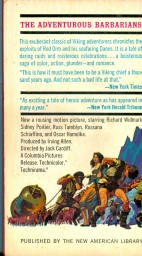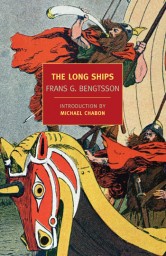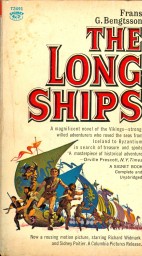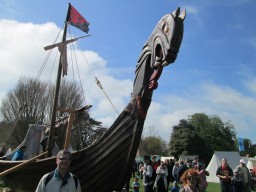Something I have noticed – hardcore readers of sword and sorcery fiction generally also read blood and thunder historical fiction. Sometimes the boundaries of the two genres are very blurry.
Vikings appear to be popular right now with the History Channel’s very historically muddled Vikings show. Bernard Cornwell’s Saxon Chonicles take place during the Viking era in England. Robert Low, Justin Hill, and Giles Kristian are current writers of that era.
It goes back to the Victorians when William Morris translated Icelandic Sagas in 1869. H. Rider Haggard caught the disease with Eric Brighteyes (1891) and The Wanderer’s Necklace (1914). E. R. Eddison doubled down with Egil’s Saga (1930) and Styrbiorn the Strong (1926).
There was a Viking Society for Northern Research that E. R. Eddison belonged. J. R.  R. Tolkien scholar Douglas A. Anderson has told me there were a number of Viking novels writing around the turn of the 19th-20th Centuries.
R. Tolkien scholar Douglas A. Anderson has told me there were a number of Viking novels writing around the turn of the 19th-20th Centuries.
So the Vikings have had good press despite the fact their main form of trade was in the form of captives sold to the Moslems. Some historians even view the rise of Vikings as a result of the expansion of Islam and its insatiable desire and need for slaves. My Celtic blood compels me to view Vikings in a less romantic light. After all, Ireland is where Vikings went to die. In the end, Irish axes broke the Viking jarls at Clontarf in 1014 A.D. and allowed the Scandinavian kings to extend control over them.
What is the greatest Viking novel? There are contenders– E. R. Eddison’s Styrbiorn the Stong, H. Rider Haggard’s Eric Brighteyes, Poul Anderson’s Hrolf Kraki’s Saga, Edison Marshall’s The Viking.
I will put forth the greatest Viking novel is Frans G. Bengtsson’s The Long Ships. Bengtsson was a Swede who originally wrote The Long Ships as two books, which were later combined. Michael Meyer translated the book into English.
Some of you may have seen the movie of the same name starring Richard Widmark and Sidney Poitier. The movie adapts maybe the first 20% of the novel and with big changes.
The novel takes place from 980-1010 A.D. Vikings take young Red Orm from Skania (part of Denmark at the time) raiding his father’s farm for food. The intrepid Vikings end up in Spain captured by the Moors. Orm and others end up in Al Mansur’s army for years before returning home.
Part 2 takes place in Ethelraed the Unready’s England with the Battle of Maldon as part of the events. Orm is also superficially converted to Christianity.
Part 3 has Orm building a home in Scania in the border country with the Swedes. Part 4 has a last foray to find a treasure on the steppes of Ukraine with the title “Bulgar Gold.”
Bengttsson wrote The Long Ships in a fashion similar to the sagas. It is not a pulp magazine flow but something different. Various people I have spoken to over the years who have read it all have a special spot for this novel. Many return to it.
 The recent trade paperback edition from New York Review Book Classics has an introduction by Michael Chabon.
The recent trade paperback edition from New York Review Book Classics has an introduction by Michael Chabon.
“In my career as a reader I have encountered only three people who knew The Long Ships, and all of them, like me, loved it immoderately…I dare to extrapolate that this novel, given the chance, to bring lasting pleasure to every single human being on the face of the earth.”
Chabon is the same age as me. He also attended the University of Pittsburgh the same time I did. I did not know him though I might have seen him on campus.
The Long Ships is one of those classics that belongs on the shelf of any lover of historical adventure or sword and sorcery.
A parting note- the movie had a great soundtrack like many of that time. I would love to see some sort of epic movie soundtrack boxed set as I like to listen to soundtracks in the car to and from work.
Historical Fiction is one of those genres that is so broad that it sort of loses much coherence. There are HF groups, but a huge segment is romance, with a chunk given to mystery. The Blood&Thunder school never got its own designation the way Sword & Sorcery did.
The funny thing is that REH pretty much created S&S by mixing historical settings with sheer fantasy, Solomon Kane & Bran Mak Morn. HF nowadays is dominated by Tudor material, White Queen, Wolf Hall, Bring Up the Bodies, etc.
I have not The Long Ships (mea culpa, I saw the movie), but I’m guessing it has a lot more in common with Rider Haggard’s Lost Race adventures or anything REH wrote than it does with Hilary mantel or even Sigrid Undset.
I have both editions of this book as shown, and I think it is one of the very best Viking adventures ever written. Part of the reason is because of the way it is written; kinda like the old Sagas, with a sort of poetry or cadence to the prose. Also, it can be pretty funny.
I also highly recommend the Viking fiction of Giles Kristian-kick ass blood and thunder that is not too modern in attitude or structure. All four books I have read are truly excellent, with good history, realistic battles and plenty of blood and crude humor that doesn’t cross over to scatological garbage.
I loved the movie, which I saw in the theater. I bought the book immediately (too bad Chabon never met me) and loved it. I lost that copy but bought another one years later. It is indeed a fine novel, probably the best historical novel I’ve ever read.

